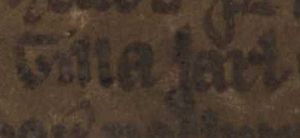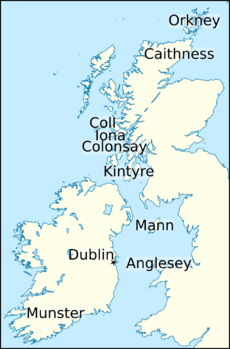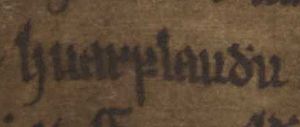Gilli (Hebridean earl) facts for kids
Quick facts for kids
Gilli
|
|
|---|---|
| Earl in the Hebrides | |

Gilli's name and title as it appears on folio 4r of AM 162 B epsilon (Njáls saga): "Gilla jarl".
|
|
| Spouse(s) | Hvarflǫð Hlǫðvisdóttir |
Gilli was an important leader in the Hebrides around the 1000s. This was a time when the powerful Earls of Orkney had a lot of control over the Kingdom of the Isles.
According to old stories called sagas, Gilli was related to Sigurðr Hlǫðvisson, Earl of Orkney. Gilli married Sigurðr's sister, Hvarflǫð. Sigurðr was one of the strongest Orkney earls. He likely expanded his power into the Isles in the late 900s. Gilli probably acted as Sigurðr's "viceroy" or "tributary earl." This means Gilli ruled the Hebrides but answered to Sigurðr.
We are not sure exactly when Gilli was in charge. It could have been as early as the time of Guðrøðr Haraldsson, King of the Isles. Or it might have been later, after Rǫgnvaldr Guðrøðarson, King of the Isles died. Gilli's name likely comes from the Gaelic language. He seems to have lived on either Coll or Colonsay, islands in the Inner Hebrides. Some historians think Gilli might be the same person as Gilla Ciaráin mac Glún Iairn. This man was a powerful leader who died in the Battle of Clontarf in 1014. If not, another idea is that Gilli was the father of a man named Conamal/Conmáel, who died in 980.
Gilli's Role in the Hebrides
There is evidence that Sigurðr Hlǫðvisson, Earl of Orkney extended his power. He moved from Orkney into the Isles in the late 900s and early 1000s. For example, the Njáls saga, an old story from the 1200s, mentions Gilli. It says that one of Sigurðr's followers collected taxes from the northern Hebrides. Gilli controlled this area.
The saga also says that Sigurðr and his men defeated Guðrøðr Haraldsson, King of the Isles. After that, they raided and took valuable things from the Isles. Other stories, like the Orkneyinga saga and Eyrbyggja saga, also talk about Sigurðr's raids. They mention him collecting taxes from the Isles. This expansion by Orkney might explain why many silver hoards (hidden treasures) from this time have been found.

Old Irish records, called Irish annals, show that this was a time of conflict in the Isles. Groups called Danair (which means "Danes" or possibly "pirates") were active there in 986 and 987. It's not clear if these Danair were Sigurðr's forces. They might have been Vikings who were attacking England around the same time.
These Danair seemed to be fighting against Guðrøðr Haraldsson. This could mean that Guðrøðr was allied with them against his enemies. Perhaps these enemies were people like Gilli, who was connected to Orkney. This suggests that the sagas, which talk about Orkney's constant conquests, might not tell the whole story. Guðrøðr was killed in 989. After his death, the political unity of the Kingdom of the Isles seemed to weaken.

We don't know the full extent of Guðrøðr's power in the Hebrides. This is because Gilli was also present, and Orkney's influence was uncertain. It's also unclear who took over after Guðrøðr. His son, Rǫgnvaldr, might have become king. It's possible that Gilli or Sigurðr took advantage of Guðrøðr's death. They might have extended their rule as far south as the Mann. However, there is no strong proof for this.
The Njáls saga says that Gilli lived on Kola or Kolu. This island seems to be either Coll or Colonsay. The saga also states that Gilli was married to Sigurðr's sister, Hvarflǫð. This marriage shows how Sigurðr's power spread south. This union, and Gilli's good dealings with Sigurðr's friends, suggest they had a close relationship. Sigurðr's family was open to marrying into local ruling families. His own mother was the daughter of an Irish king, and his wife was a Scottish king's daughter. These old stories suggest that Gilli ruled the Hebrides as a leader who paid tribute to his brother-in-law.
Gilli and the Battle of Clontarf
By the early 1000s, Brian Bóruma mac Cennétig, High King of Ireland was the main ruler in Ireland. Brian's daughter, Sláine, was married to Sitriuc mac Amlaíb, King of Dublin. Sitriuc's mother, Gormlaith, had also been married to Brian. In 1013, Sitriuc joined Brian's enemies and rebelled against him. Brian then attacked Dublin, the only Viking town that joined the revolt. But Sitriuc kept control of the city.

According to Njáls saga, Gilli and Sitriuc spent Christmas with Sigurðr in Orkney. Sitriuc convinced Sigurðr to join the fight against Brian. Sigurðr agreed, on the condition that he would marry Gormlaith. In April 1014, the two sides met at the very bloody Battle of Clontarf. Brian's forces won the battle, but both Brian and Sigurðr were killed.
Gilli appears in a part of Njáls saga that describes strange, supernatural events linked to the battle. For example, a man from Caithness supposedly saw valkyrie-like figures singing songs for the dead. Similar events were said to happen in the Faroe Islands and Iceland. The saga says Gilli himself dreamt of a song that predicted the battle's outcome. It foretold the deaths of Brian and Sigurðr. Some historians believe these supernatural parts were added to the saga later.
If the story about Gilli's dream was added for drama, it might not mean he was active after the battle. It's possible that Gilli is the same person as Gilla Ciaráin mac Glún Iairn. This man was killed at the Battle of Clontarf. The Annals of Ulster, another old record, calls Gilla Ciaráin rígdamna Gall ("heir to the throne of the Foreigners"). This shows he was a very important person.
Sitriuc, the King of Dublin, had an older brother named Glún Iairn. Glún Iairn was King of Dublin until he died in 989. If Gilla Ciaráin was Glún Iairn's son, he would have been very young when his father died. This could explain why Sitriuc became king instead. The title given to Gilla Ciaráin suggests he was seen as his uncle's royal heir. If Gilli and Gilla Ciaráin are the same person, his high status would explain his marriage to Sigurðr's sister.
Gilla Ciaráin's father had a Gaelic name meaning "iron knee." This might be a Gaelic version of an Old Norse name with the same meaning. Gilla Ciaráin's own name is Gaelic, meaning "the servant of Saint Ciarán." Gaelic names starting with "Gilla-" first appeared in the late 900s. Scandinavian settlers in Britain and Ireland often shortened these names to "Gilli." This might explain Gilli's name. Gilli's name suggests he was at least partly of Gaelic descent, perhaps from Ireland or the Hebrides. The best version of Njáls saga says Gilli's wife was named Hvarflǫð. This name seems to be an Old Norse form of the rare Gaelic name Forbflaith.
There might be more clues about Gilli's family. In 980, Máel Sechnaill mac Domnaill, High King of Ireland defeated Amlaíb Cuarán's forces at the Battle of Tara. One of the people killed was a man called "Conamhal m. airri Gall" in the Annals of Ulster. Other records call him "Conmael mac Gilli Airi."
It's possible these records refer to a man named Conamal or Conmáel, whose father was named Gilli. And either the father or the son held the title airrí Gall ("royal deputy of the Foreigners"). If this is true, this father Gilli could be the same Gilli from the sagas. However, the sagas show Gilli active around the time of the Battle of Clontarf (1014). The long time gap between Conamal/Conmáel's death (980) and the Battle of Clontarf makes it unlikely that Gilli was Conamal/Conmáel's father. The old records seem confused about whether the name refers to a person or a title.
See also
- Ásbjǫrn skerjablesi, a ninth-century Hebridean earl






